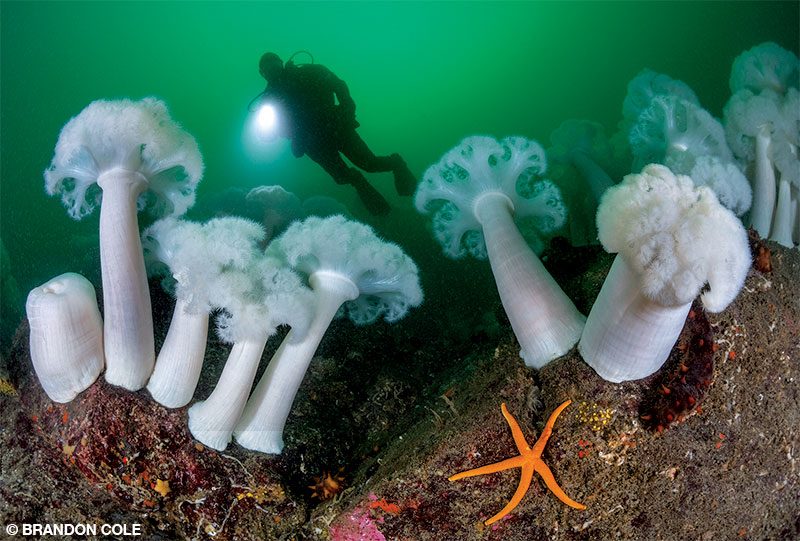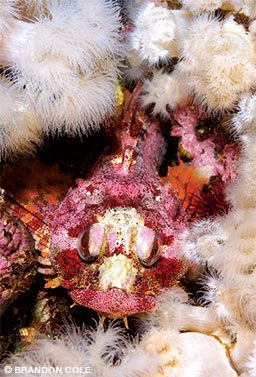British Columbia’s backyard fjord
Con casi 16.000 millas de escarpada costa y más de 40.000 islas e islotes, Columbia Británica, la envidiable riqueza oceánica de Canadá, ofrece una fantástica vida marina y espectaculares aventuras de submarinismo en aguas frías. Aquí hay más de lo que se puede disfrutar en toda una vida.
Most local divers take their first giant strides in Howe Sound. Stretching 27 miles from its narrow head under lofty mountain peaks at Squamish to its wide-mouth opening into the Strait of Georgia just northwest of Vancouver, Howe Sound is North America’s southernmost fjord. This sea-to-sky corridor crafted by glaciers and perfected by time seems tailor-made for subsea exploration — reef and wreck, rec and tech.

Hora feliz en el lugar de la firma
El punto de inmersión más popular del área metropolitana de Vancouver es Parque Whytecliff, where the high-rising fjord wall towers above and mirrors below the waterline. The site’s name is self-evident at 60 feet, where a field of snowy white plumose sea anemones spills over the edge of a wall that plunges 600 feet deep. Velcro-armed feather stars, blood stars, orange sea pens and armor-plated Puget Sound king crabs share space in the Metridiumjardín. Los grupos de esponjas nubosas empiezan a brillar a los 85 pies. Las colonias de esponjas iluminan el abismo desde 30 cm hasta el tamaño de un coche pequeño. Entre los pliegues de las masas de esponja macaroni de color marfil y mantequilla se esconden peces de roca cobrizos y amarillos, cangrejos litodémicos espinosos y langostas rechonchas.

But it’s not all steep and deep at Whytecliff. Inside the sheltered cove over a sandy bottom 15 to 40 feet deep, kelp and boulders provide habitats for shrimp, bulgy-eyed flatfish and blackeye gobies. Diving after sunset increases the odds of seeing nocturnally active sailfin sculpins, midshipman fish, giant Pacific octopuses and, in winter, stubby squid.
Divers of all stripes flock to Whytecliff Park, which in 1993 became Canada’s first saltwater marine protected area. This perennial favorite is busy year-round. New divers mingle in the shallows for open-water certification classes. Techies tricked out with rebreathers stealthily swim 10 minutes around the point to El corte o directamente al Marcador de díato drop over the sheer wall. There’s also a third dive at Islote Whyte to the left. Some people swing by the park after work — dedicated divers will drive an hour from the crush of Vancouver city — to celebrate a serene happy hour with the fishes; others make a weekend of it, bringing a six-pack of cylinders. The park has restrooms, free parking, a rinse station and even a café. Air fills and gear are available from the dive shop in the nearby idyllic village of Horseshoe Bay. Whytecliff is shore-entry only. A garden cart is helpful to lug heavy gear between the parking lot and the beach below.
Autopista del Mar al Cielo

Los lugareños más avispados también trabajan sobre ruedas en Kelvin Groveen la Bahía de los Leones, transportando sus equipos de submarinismo en carros o carretillas de mano del automóvil al océano. Su recompensa les espera en la punta de la derecha. La parte superior de la pared muestra estrellas de mar púrpuras amontonadas en un scrum de rugby, pepinos de mar anaranjados y blancos y bancos de luciopercas. En las profundidades intermedias habitan coloridos o camuflados señores irlandeses rojos, muchos tipos de nudibranquios (limón, esmerilado, payaso), verdeles de algas, escualos búfalo y escualos roncadores. Entre las bellezas que se esconden en las grietas más profundas se encuentran la brótula roja, parecida a la anguila, y el pez tigre, pintado con colores llamativos. Merece la pena moverse despacio por debajo de los 30 metros y examinar detenidamente las aberturas de las esponjas chimenea y las esponjas nube en busca de redes o cañones decorados. Este lugar puede ser muy productivo para la macrofotografía.
Conduciendo 8 millas hacia el norte por la autopista 99, la Sea-to-Sky Highway, se llega a Parque Provincial de Porteau CoveOtro elemento básico del submarinismo costero en Howe Sound, pero con giros interesantes. En primer lugar, no es necesario subir montañas; las escaleras proporcionan un acceso rápido y fácil al mar. En segundo lugar, el arrecife es de acero, madera, caucho y hormigón. Porteau es una colección de barcos hundidos (la mayoría de acero y los de madera están muy deteriorados), un arrecife de neumáticos, montones de bloques y columnas de hormigón y un gimnasio de vigas metálicas.

Enormes bogavantes de 75 libras, entronizados regiamente sobre restos de naufragios, acechan disimuladamente en las sombras. Tunicados, briozoos y crinoideos se aferran a las estructuras sintéticas. Los gobios y los peces de roca merodean, y abundan los rumores de guaridas ocultas de anguilas lobo. Las boyas de superficie marcan las principales atracciones, como el Centenario III y la draga de 92 pies Granthallun remolcador de acero reconvertido posteriormente en empacador de arenques. Bajo su popa, anémonas plumosas de un metro de altura cuelgan como elegantes lirios de Pascua invertidos o luminosas lámparas de araña vivientes.
Porteau Cove is an excellent place to practice underwater navigation while moving from feature to feature. Visibility is sometimes low, but modest depths ranging from 25 to 50 feet and the plethora of artificial reef structures deliver extra bottom-time enjoyment. But if the wind is blowing 15 knots or more — especially from the west or north — knowledgeable divers will postpone Porteau until a calmer day.
Corazón del fiordo
Los submarinistas necesitan un barco para ver todo lo que ofrece Howe Sound. Las salidas desde Horseshoe Bay dan acceso al corazón del fiordo, donde docenas de lugares estelares entre las islas surgen de las frías aguas esmeralda de este vasto paisaje marino interior. Un paseo en barco de 20 minutos le llevará a Parque Provincial Marino de Halkett Bayon Gambier Island’s southeast corner. Submerged in the protected bay lies the HMCS Annapolisun buque de guerra de clase destructor hundido intencionadamente en 2015. El buque de 366 pies de eslora Annapolis is the eighth addition to the Artificial Reef Society of British Columbia’s world-class ships-to-reefs program, enhancing both the recreational diving opportunities and the marine wildlife habitat. It takes many tanks to explore the mammoth wreck from bow to stern. It rests upright in the sand at 110 feet, but much of its structure is between 50 and 80 feet, with everything meticulously prepared for diver safety. There are no entanglement hazards, the hull and decks have numerous entry and exit holes, and there are three buoyed descent and ascent lines.

El Pináculo off Bowyer Island’s north side is also a memorable experience top to bottom, but of the rock variety. Also called Wedding Cake, the site offers a range of profiles so divers can choose one appropriate to their skill level. The pinnacle’s tip peaks at only 15 feet below the waves, and deeper tiers fall away below. The layers of life include the usual profusion of anemones plus zoanthids, numerous crab species, giant nudibranchs and fish large and small, from lunker lings and wolf eels to tiny gruntlings. Don’t ignore piles of empty clam shells and crab parts. These messy leftovers hint that a well-fed octopus lives nearby. Bowyer’s Muro Este serves up a variety of jellies — fried egg, lion’s mane, moons and more — that drift along its precipitous drop. Cañones, on Bowyer’s south side, earns five-star reviews for its diverse mix of terrain (sheer wall, rocky ridges and sandy gullies) and a smorgasbord of fish and invertebrate species.

Cinco millas más adentro, donde el fiordo se estrecha en su camino serpenteante hacia el norte, Isla del Yunque has a handful of sites around it that locals and visitors alike rank among Howe Sound’s finest boat dives. Christie Islet ofrece una aventura a elegir desde los 15 metros hasta más allá de los 100, con rincones y grietas repletos de criaturas. Está dirigido tanto a buceadores con inquietudes biológicas, deseosos de poner a prueba sus habilidades de identificación de la vida marina, como a fotógrafos obsesionados con la búsqueda quijotesca de la foto perfecta.

The strong currents that are a trademark of diving in much of British Columbia — and a driving force behind the ecosystem’s abundance — rarely limit underwater activities in Howe Sound. The waters can get moving at Dragon’s Den, but it’s often just a surface current, and sometimes there’s flow at depth. Experienced captains and divemasters assess the conditions and then thoroughly brief divers before opening the back deck. Once submerged, divers should carefully monitor and manage gas supply, time and depth and be ready to adapt to changing conditions. At this sometimes challenging, always exhilarating advanced location, stunning topography is the ticket. The wall angles back on itself, tilting past vertical to create magnificent overhangs with curtains of ghostly plumose anemones. For divers hovering in the shadowy void of these cavernlike recesses loaded with sea life but lacking a bottom, the view is a mindbender not soon forgotten.
Visite la página de Pam Rocks para un cambio de ritmo y encuentros con la carismática megafauna. Este grupo de islotes al sur de la isla Anvil es un lugar de descanso para las focas comunes. Decenas de ellas se reúnen en verano, disfrutando como si fueran patatas en el sofá en perchas rocosas justo por encima de la línea de flotación. Bucear con tubo es la mejor forma de interactuar con las focas. Deje que se metan en el agua y se acerquen a usted cuando estén preparadas; con el tiempo, su curiosidad les vencerá.
Keep calm and marvel on. Look down to watch playful seals circling below you in the emerald sea; look up to be gobsmacked by the Coast Mountains soaring to kiss the sky. It’s a peerless view both above and below — the perfect Howe Sound half-in, half-out surface interval before the next dive.
Cómo bucear en este lugar
Condiciones: Howe Sound is a year-round dive destination. The inland waters are sheltered from the open Pacific Ocean’s storms and swells, but strong winds can funnel through the fjord. Sea surface conditions vary from flat to rough and white-capped. There is always a protected spot somewhere to dive. Ocean temperatures usually hover in the mid-40°F range at depth and up to 52°F at the surface. Thermoclines and freshwater layers may be present, especially after heavy rains and snowmelt in the interior. Drysuits allow you to customize undergarment thickness to your thermal tolerance.
La claridad del agua suele ser mejor a finales de otoño e invierno, cuando la visibilidad suele oscilar entre los 25 y 75 pies. Las floraciones de plancton pueden reducir la visibilidad en primavera y verano, pero los buceadores pueden encontrar una mayor claridad del agua bajo una capa superficial turbia. En algunos lugares hay corriente, por lo que los buceadores deben tener cuidado y bucear preferentemente con marea alta o baja. En general, sin embargo, en Howe Sound no es necesario bucear con marea baja, como en muchos otros lugares de la Columbia Británica. El tiempo por encima de las olas varía mucho, de soleado y cálido a fresco, lluvioso y ventoso.
With a full gamut of dive sites — deep walls, shallow bays, muck dives, shipwrecks, seamounts and pinnacles — there are spots suitable for divers of all skill levels and interests. Many sites have deep water well beyond recreational limits, so proper training, planning and good buoyancy control are essential.
Cómo llegar: Horseshoe Bay, la puerta de entrada al submarinismo Howe Sound, es un suburbio de West Vancouver y está a unas tres horas en coche de Seattle (Washington) o a una hora del centro de Vancouver (Columbia Británica). El tráfico y los cruces fronterizos pueden aumentar los tiempos de tránsito.
Explore más
See more of Brandon Cole’s images of Howe Sound in a galería de fotos complementaria.
© Alert Diver —primer trimestre 2021.